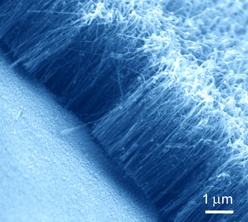May 20 2009
A $1.3 million State Government grant will help Queensland University of Technology create a new class of solar-powered nano-sensors capable of detecting pollution and monitoring the environment in remote areas.
 Nano-tubes grown at QUT.
Nano-tubes grown at QUT.
Lead researcher Professor Nunzio Motta, from QUT's School of Engineering Systems, said nanotechnology had the potential to revolutionise current farming and environmental management techniques.
Professor Motta said up until now it had been too costly and very difficult to collect and monitor data revealing the environmental conditions experienced in remote areas.
"These sophisticated nano-sensors which we are developing and which will use very little power, will provide a more accurate picture of what is happening in the environment, and will help farmers monitor their crops in remote areas," he said.
Professor Motta said the nano-sensors, which were located in a self-contained box and could be placed where needed, were based on microscopic tubes and wires too small to be seen by the naked eye.
"The nano-tubes being developed at QUT are tiny carbon tubes with a diameter of a few millionths of a millimetre, much smaller than a human hair, and will be covered by the sensing molecules," he said.
"The nano-wires which are being developed in Italy, are metallic oxide needles of the same size, and will not require sensing molecules.
"Their hair-like structure increases the sensitivity of the detector because of the huge surface exposed with respect to conventional flat sensors."
Professor Motta said the sensors would be powered by a new kind of solar cell developed in Australia by Dyesol, and would transmit data to monitoring stations using radio or Universal Mobile Telecommunications System (UMTS) technology.
"This will provide a low-cost method to monitor air, water, land and crop conditions, and assist in the control of pollution levels and gas and carbon emissions," he said.
"What we have proposed is that in the first year we will develop the nano-structures, in the second year we will work on the electronics, and in the third year we will deploy the sensors for testing."
The project is a collaboration involving QUT, Central Queensland University, the Brescia and Roma Tor Vergata universities in Italy, and Dyesol, one of Australia's leading suppliers of solar technology.